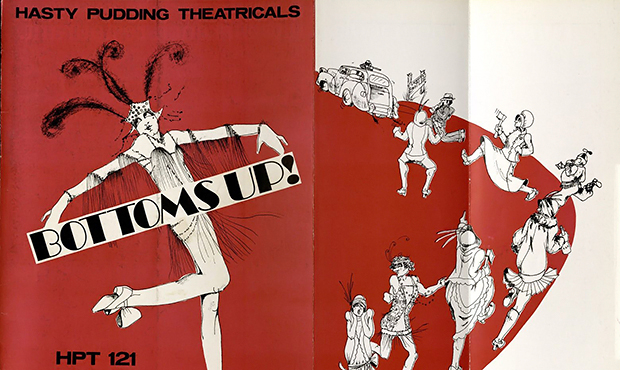Hasty Pudding Theatricals

Farkas Hall is home to the Hasty Pudding Theatricals, Harvard’s first social club, with famous members such as Teddy Roosevelt, Jack Lemmon, Charles Sumner, and Oliver Wendell Holmes. Hasty Pudding was founded in 1795 in Nymphas Hatch’s dorm room. Its members were sworn to secrecy and it was decided that at every meeting, one member must provide a pot of hasty pudding, a sort of cornmeal mush that gives the group its name. While today we think of Hasty Pudding as a group that creates original musicals with men dressed in drag, it was not always so. Hasty Pudding was originally a social group that would end their meetings by singing with a profane tongue. But in 1800 their first foray into any form of theatrics occurred.
In 1800 a trial was held to try a member for insolence and contempt of the club. A court of criminal and civil jurisdiction was formed, which included lawyers, a judge, and a jury of the remaining members. The accused was found guilty and was fined 17 cents, which was then used to purchase apples. The group thought that this trial was so much fun that they changed their constitution to include trials. In 1801 the constitution mandated that two trials, real or supposed, must be performed at each meeting. So they would try Brutus, Cortez, or Elizabeth Tudor for their crimes, and of course find them guilty. In 1836 the defendant and witnesses appeared in costume, and these mock trials became a sort of courtroom drama. In 1837 the first cross-dressing occurred.
In 1844 Hasty Pudding staged their first play. Lemeul Hayward staged the tragicomic burlesque opera, Bombastes Furioso, in his dorm room, Hollis 11. While it was not an original play, it was unique in production, being staged in a dorm room with men in drag, as well as ad-libs and specialty acts, not to mention that the boys would stay in their dresses after to eat pudding. In 1850, the group added its first original song the end of The Windmill and in 1855 they turned Tom Thumb into The Grand Opera of Tom Thumb. By the mid-1860’s they were creating entirely original shows, from writing to production.
In 1888 the club moved to its current location after all clubs were kicked off campus due to a fire started by one of the clubs. The Pudding’s new location allowed for 30 or more performers and in the 1890’s the club grew to be supported by the wives of Teddy Roosevelt, Robert Winthrop, and J. Pierpont Morgan. In the 20th century the club was affected by the world wars. Between 1917 and 1919 the entire club enlisted, 15 died and 12 were wounded. But Hasty Pudding retuned in the 1920’s with a bigger budget of $12,000. This extra cash allowed them to take their shows on the road to New York. This larger budget continued until World War Two and dropped significantly afterwards.
The 20th century also saw the arrival of women in Hasty Pudding. Pudding had originally been a male-only club, with the men who specialized in women’s roles becoming known as pudding divas. But in 1920 Pudding had its first female producer, and in 1973 the club became officially coed, allowing women to work backstage. The 20th century also saw the Pudding creating their man and woman of the year awards, a ceremony in which a celebrity is brought to Harvard, given a parade, a trophy, a roast, and a seat the pudding’s main show. The woman of the year award began in 1951 and has continued ever since, with winners including Halle Berry, Julie Andrews, and Katherine Hepburn. The man of the year award began in 1967 and has been given to Harrison Ford and Clint Eastwood among others.